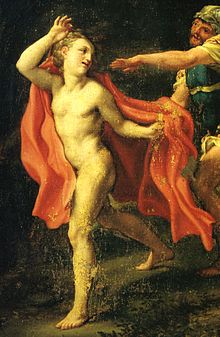Unidentified figure mentioned briefly in the Gospel of Mark

The naked fugitive (or naked runaway or naked youth) is an unidentified figure mentioned briefly in the Gospel of Mark, immediately after the arrest of Jesus in the Garden of Gethsemane and the fleeing of all his disciples:
A certain young man was following him, wearing nothing but a linen cloth. They caught hold of him, but he left the linen cloth and ran off naked.
The parallel accounts in the other canonical Gospels make no mention of this incident.
The wearing of a single cloth (Greek: σινδόνα, sindona) would not have been indecent or extraordinary, and there are many ancient accounts of how easily such garments would come loose, especially with sudden movements.
Identity
Since ancient times, many have speculated on the identity of this young man, proposing:
- James the Just
- The Beloved Disciple (John)
- Mark himself
- Lazarus of Bethany
- An antitype of Joseph
- Simply someone else who happened to be there.
A later verse in Mark, "And entering the tomb, they saw a young man sitting on the right side, dressed in a white robe," is often connected to the passage by allegorical readers of (in the words of Howard M. Jackson) the "symbolism school".
The naked fugitive has been speculated to originate in a possible Passion narrative that pre-dates the gospel of Mark. In such an early document, anonymity of the fugitive may have protected this individual from official persecution.
See also
References
- "Bible Gateway passage: Mark 14:51 - New Revised Standard Version Updated Edition". Bible Gateway. Retrieved 16 December 2024.
- ^ Bauckham, Richard (2017). Jesus and the Eyewitnesses: The Gospels as Eyewitness Testimony. Wm. B. Eerdmans. ISBN 978-1-4674-4680-8.
- Epiphanius of Salamis, Panarion 78.13.2
- Ambrose, Exp. Ps. 36 60.
- Chrysologus, Peter (2005). "Sermon 78". Selected Sermons. CUA Press. pp. 31–. ISBN 978-0-8132-0110-8.
- Allen, Rupert (2008). "Mark 14,51-52 and Coptic Hagiography" (PDF). Biblica. 89 (2): 265–268. JSTOR 42614826. Allen studies the origins of this theory and finds it first mentioned in a 13th-century manuscript.
- Haren, M. J. (1998). "The naked young man: a historian's hypothesis on Mark 14,51-52". Biblica. 79 (4): 525–531. JSTOR 42614166.
- Waetjen, Herman (1965). "The Ending of Mark and the Gospel's Shift in Eschatology". Annual of the Swedish Theological Institute.
- Mk 16:5
- Jackson, Howard M. (1997). "Why the Youth Shed His Cloak and Fled Naked: The Meaning and Purpose of Mark 14:51-52". Journal of Biblical Literature. 116 (2): 273–289. doi:10.2307/3266224. JSTOR 3266224.
- Cook, Michael J. (1978). Mark's Treatment of the Jewish Leaders. Brill. p. 54. ISBN 90-04-05785-4.
| Gospel of Mark | |
|---|---|
| Bible chapters (New Testament) | |
| Events | |
| Phrases | |
| People |
|
| Places | |
| Related | |
| In music | |
| Manuscripts | |
| Sources | |